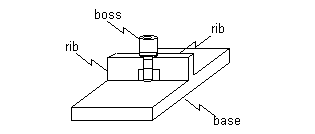3.0 A FEATURE-BASED DESIGN EVALUATION SYSTEM
3.1 FEATURE ABSTRACTIONS
The mission of the Design for Molding system is to bring downstream manufacturing concerns in the domain of plastic injection molding up front into the design stage. The DFM system is the designation used for the entire suite of tools and representations used to accomplish this mission. Applications of the DFM system participate in reducing the cost of iterations in the conceptualization, implementation, and interaction of the ASE design cycle, particularly by detecting potential manufacturing defects well before a physical prototype is constructed.
This section addresses the information flow and feature abstraction process required for knowledge-based manufacturability analysis, particularly considering net shape manufactured parts such as those of plastic injection molding. Net shape manufacturing includes processes by which the final form of a metal or plastic part is achieved within a single operation. Casting, injection molding, stamping, and extrusion exemplify such processes.
A survey of the techniques conducted by [Gadh & Prinz 91] indicates that numerical simulation techniques are limited in the scenarios to which they can apply. Also, the simplifying assumptions necessary for solving equations may make the results unacceptable with respect to the actual manufacturing process. Research was undertaken to provide a system whereby the expertise and knowledge of a molding expert could be consistently used.
Knowledge engineering techniques for design analysis are motivated and advanced by [Frederick et al 83] [Gadh et al 89] and [Fu et al]. These approaches rely on design standards and the heuristics of experts which are compiled within a knowledge base in the form of rules. These rules generally make use of forms known as features, which are abstractions from the original design model. Some feature classes in net shape manufacturing include ribs and bosses as illustrated in Figure 12.
Figure 12 Plastic Injection Molding Artifact

A CAD model intended for net shape manufacturing can include much of the geometric and topological information required for a feature-based analysis. In the forming domain, a given model can be substantially analyzed for manufacturability with little consideration of secondary milling or other shape-altering operations.
Features are entirely obtained from the original CAD model. Conventional CAD systems do not contain feature abstractions, so a given CAD representation is submitted to a series of transformations. These transformations result in a series of representations which produce the ultimate goal of a critique and visualization of the model.
Two feature extraction methods developed to provide objects for a knowledge-based system evaluation are outlined in this section. The Differential Depth Perception Filter method is analogous to a human's discerning of object outlines in recognizing features. The Skeletonization approach burns away the outermost layers of a part until more readily recognized entities remain.
The methodologies presented first start with reducing the search requirements of the problem space. This is accomplished by abstracting entities from the original representation through transformation and/or filtering to an alternate representation. Entities specific to the alternate representation are abstracted; these abstractions are matched against predefined templates for feature classification. Feature extraction is complete when feature recognition and classification occurs and when each feature's attributes are evaluated.
An application called upon by the DFM system is the Plastic Injection Molding Expert System (PIMES). The PIMES system performs a knowledge-based manufacturability assessment of plastic injection molded parts based on their CAD models. It also uses information available from the design to determine mold specifications and machine requirements. PIMES uses heuristics based on the standards and expertise developed by design and molding engineers at Inland Fisher Guide, a division of General Motors. These heuristics are formally represented as rules within a knowledge base and rely on key aspects of a parts' form features.
The PIMES system acts as the repository of heuristic rules used for evaluating manufacturability. By examining the geometric model and form features, PIMES can act as a critic of the design. Constraint violation information is deduced in the analysis of feature data with applied knowledge. For example, in injection molding, the possibility for a common formation defect known as a "sink" may be detected by evaluating the attribute values of these features. Sinks can occur where there is a relatively greater bulk of material at the joint of the projecting feature and the base than the surrounding area. During the cooling stage, heat transfer is slower at the joint and uneven shrinkage may occur, resulting in a surface depression known as a sink [Bralla 86].
Heuristics such as that for the sink are formalized in terms of features. If a relation value becomes greater than some critical value for structural, functional, or visibility requirements, the part is considered to be non-formable. Correlating to the previous example, the thicker the projecting feature T with respect to the base B the greater is the amount of material cooling, and the greater is the magnitude of the sink. Therefore, one method to eliminate the sink, is to make the ratio of T/B smaller than the value that which is acceptable for sinks [Dym 79]. This is the first step toward formalizing heuristics for computation.
A concurrent manufacturing environment should allow a number of design perspectives to be integrated. At the center of this activity may be a neutral design representation, continually evaluated, modified, and augmented during the design process. A common theme is developed in the engineering of technologies for the concurrent engineering environment. Entities are abstracted to provide a reduced problem space and use more effective search strategies. Then these entities are recognized and classified and the attributes inherited from the classification are evaluated. Additionally, mapping to or from the neutral representation should occur so that the results exist as integrated enhancements to the model should further automated processing require use of these.